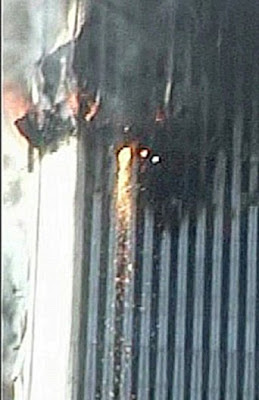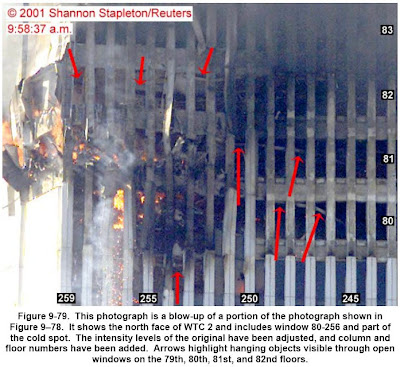cont. from Wikipedia
https://en.wikipedia.org/wiki/John_F._Kennedy_assassination_Dictabelt_recording
Richard E. Sprague, an expert on photographic evidence of the assassination and a consultant to the HSCA, noted that the amateur film the HSCA relied on showed that there were no motorcycles between those riding alongside the rear of the presidential limousine and H.B. McLain's motorcycle, and that other films[SUP]
[21][/SUP][SUP]
[not in citation given][/SUP]
showed McLain's motorcycle was actually 250 feet behind the presidential limousine when the first shot was fired, not 120 to 138 feet. No motorcycle was anywhere near the target area.[SUP]
[22][/SUP]
The adult magazine Gallery published a flexi disc of the Dictabelt recording in its July 1979 issue.[SUP]
[23][/SUP]
Ohio rock drummer Steve Barber listened to that recording repeatedly and heard the words "Hold everything secure" at the point where the HSCA had concluded the assassination shots were recorded.[SUP]
[3][/SUP]
However, those words were spoken by Sheriff Bill Decker about a minute after the assassination, so the shots could not be when the HSCA claimed.[SUP]
[24][/SUP]
The Technical Services Division of the FBI studied the acoustical data and issued a report on December 1, 1980 (dated November 19, 1980). The FBI report concluded that the HSCA failed to prove that there were gunshots on the recording and also failed to prove that the recording was made in Dealey Plaza. In fact, using the techniques of the previous investigators, the FBI matched a gunshot recorded in Greensboro, NC in 1979 with the sound that was supposedly a shot from the grassy knoll - proving that the initial investigation's methods were invalid.[SUP]
[25][/SUP]
National Academy of Sciences[edit]
After the FBI disputed the validity of the acoustic evidence, the Justice Department paid for a review by the National Academy of Sciences, an organization operating with a Title 36 congressional charter.
On May 14, 1982, the panel of experts chaired by Harvard University's Norman Ramsey, released the results of their study.[SUP]
[26][/SUP]
The NAS panel unanimously concluded that:The acoustic analyses do not demonstrate that there was a grassy knoll shot, and in particular there is no acoustic basis for the claim of 95% probability of such a shot.
The acoustic impulses attributed to gunshots were recorded about one minute after the President had been shot and the motorcade had been instructed to go to the hospital.
Therefore, reliable acoustic data do not support a conclusion that there was a second gunman."[SUP]
[27][/SUP]
According to Ramsey, noises on the Dictabelt were "probably static".[SUP]
[28][/SUP]
Louis Stokes, a member of the
United States House of Representatives who chaired the HSCA, commented that the report "raised new and serious questions about our conclusions that need to be resolved."[SUP]
[26][/SUP]
Dr. Barger, the HSCA's acoustics expert, when asked about this discovery and the NAS analysis, replied,
Barber discovered a very weak spoken phrase on the DPD Dictabelt recording that is heard at about the time of the sound impulses we concluded were probably caused by the fourth shot. The NAS Committee has shown to our satisfaction that this phrase has the same origin as the same phrase heard also on the Audograph recording.[SUP]
[29][/SUP] The Audograph recording was originally made from the channel 2 radio. The common phrase is heard on channel 2 about a minute after the assassination would appear, from the context, to have taken place. Therefore, it would seem . . . that the sounds that we connected with gunfire were made about a minute after the assassination shots were fired. Upon reading the NAS report, we did a brief analysis of the Audograph dub that was made by the NAS Committee and loaned to us by them. We found some enigmatic features of this recording that occur at about the time that individuals react to the assassination. Therefore, we have doubt about the time synchronization of events on that recording, and so we doubt that the Barber hypothesis is proven. The NAS Committee did not examine the several items of evidence that corroborated our original findings, so that we still agree with the House Select Committee on Assassinations conclusion that our findings were corroborated[SUP]
[30][/SUP]
An analysis published in the March 2001 issue of
Science & Justice by Dr. Donald B. Thomas used a different radio transmission synchronization to put forth the claim that the National Academy of Sciences panel was in error. Thomas' conclusion, very similar to the HSCA conclusion, was that the gunshot impulses were real to a 96.3% certainty. Thomas presented additional details and support in the November 2001 and September and November 2002 issues.[SUP]
[31][/SUP][SUP]
[32][/SUP][SUP]
[33][/SUP][SUP]
[34][/SUP] Commenting on Thomas's study, G. Robert Blakey said: "This is an honest, careful scientific examination of everything we did, with all the appropriate statistical checks."[SUP]
[35][/SUP] In 2005, Thomas' conclusions were rebutted in the same journal. Ralph Linsker and several members of the original NAS team, (
Richard Garwin,
Herman Chernoff,
Paul Horowitz, and Ramsey) reanalyzed the timings of the recordings and reaffirmed in an article in
Science & Justice the earlier conclusion of the NAS report that the alleged shot sounds were recorded approximately one minute after the assassination.[SUP]
[36][/SUP]
Further analysis[edit]
The
Justice Department reviewed the HSCA report and the National Academy of Science's study of the acoustical evidence. It reported to the
Judiciary Committee on March 28, 1988, and rebuked the HSCA's conclusion of a probable conspiracy.[SUP]
[37][/SUP]
In 2003, an independent researcher named Michael O'Dell reported that both the National Academy and Dr. Thomas had used incorrect timelines because they assumed the Dictabelt ran continuously. When corrected, these showed the impulses happened too late to be the real shots even with Thomas's alternative synchronization. In addition, he showed that, due to a mathematical misunderstanding and the presence of a known impulse pattern in the background noise, there never was a 95% or higher probability of a shot from the
grassy knoll.[SUP]
[38][/SUP]
A November 2003 analysis paid for by the cable television channel
Court TV concluded that the putative gunshot impulses did not match test gunshot recordings fired in Dealey Plaza any better than random noise.[SUP]
[39][/SUP] In December 2003, Thomas responded by pointing out what he claimed were errors in the November 2003 Court TV analysis.[SUP]
[40][/SUP]
Digital restoration[edit]
In 2003,
ABC News aired the results of its investigation on a program called
Peter Jennings Reporting: The Kennedy Assassination: Beyond Conspiracy. Based on computer diagrams and recreations done by
Dale K. Myers, it concluded that the sound recordings on the Dictabelt could not have come from Dealey Plaza, and that Dallas Police Officer H.B. McLain was correct in his assertions that he had not yet entered Dealey Plaza at the time of the assassination.
In the March 2005 issue of
Reader's Digest, it was reported that Carl Haber and Vitaliy Fadeyev were assigned with the task of digitally restoring Dictabelt 10 by Leslie Waffen from the National Archives. Their method consisted of using sensors to map the microscopic contours of the tracks of old sound recordings without having to play them using a stylus, which would further degrade the sound. Dictabelt 10 was worn from countless playings and cracked due to improper storage.[SUP]
[41][/SUP] By 2010 digital restoration of the Dictabelt seemed a more distant prospect, with both funding and final approval for the project unlikely to be secured in the near future.[SUP]
[citation needed][/SUP]
Possible origins[edit]
Left unanswered by the professional analyses was the question of whose open microphone captured the sounds recorded on the Dictabelt, if not Officer H.B. McLain. Jim Bowles, a Dallas police dispatcher supervisor in November 1963, and later Dallas County Sheriff, believes it originated from a particular officer on a three-wheeled motorcycle stationed at the
Dallas Trade Mart, the original destination of President Kennedy's motorcade, along the same
freeway to
Parkland Hospital, which would account for the sound of sirens rushing by. McLain himself believes that it was from a different officer on a three-wheeler near the Trade Mart, who was known for his whistling. When interviewed by author
Vincent Bugliosi, the officer acknowledged that his microphone could have been stuck in the open position (he did not recall hearing any transmissions for several minutes), and could later have become unstuck after he followed the motorcade to Parkland Hospital.[SUP]
[42][/SUP]
Further reading[edit]



















